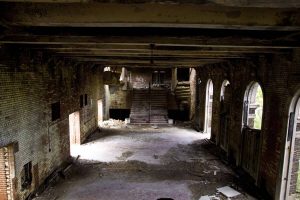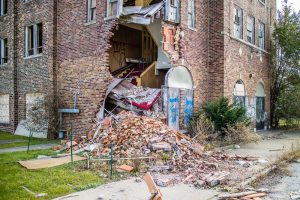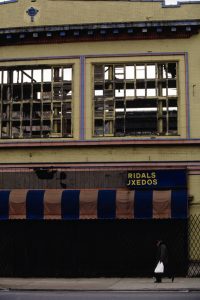In 1957, the musical The Music Man debuted on Broadway and became a sensation. One of the featured songs was Gary, Indiana, in which the huckster protagonist, Harold Hill, belts out:
I will say without a moment of hesitation
There is just one place that can light my face
Gary, Indiana, Gary, Indiana

Just 6 decades later, Gary, Indiana is anything but a light; rather, Gary, much like many US cities, has descended into darkness. So deplorable are the conditions that Business Insider named Gary the Most Miserable City in US. It’s a familiar tale: offshoring of factories and jobs, spiraling crime, rampant drug abuse, and widespread poverty have reduced a once vibrant, upwardly mobile city of nearly 200,000 residents to an economically depressed and visually blighted town of less than 75,000.
According to the latest data trends, Gary “is currently declining at a rate of -0.44% annually and its population has decreased by -7.57% since the most recent census, which recorded a population of 80,294 in 2010. An aging population will likely exacerbate conditions. Indiana University projects “Indiana will grow older, with the share of the Hoosier population age 65+ jumping from 14.6 percent to 20.9 percent.”

Although Gary rebounded from the deaths-spiral that gripped it in the 1990s (Gary was dubbed the “murder capital” of the United States), its current state is bleak. A drug-enforcement agent who grew up in the area captured the sad state of affairs in an ironic statement: “We used to be the murder capital of the US, but there is hardly anybody left to kill. We used to be the drug capital of the US, but for that you need money, and there aren’t jobs or things to steal here.”
Gary is emblematic of the growing racial polarization consuming our struggling urban centers. Currently, African Americans constitute nearly 85% of the population. A combination of historical segregationist policies in conjunction with a dying manufacturing sector caused “…descendants of European immigrants [to be] emptied out of the city, [and] the population declined dramatically to 116,646 by 1990, while the proportion of African Americans rose to over 80 percent. Many of these residents are mired in poverty. The website citydata.com list these sobering statistics:

30.0% of Gary, IN residents had an income below the poverty level in 2019, which was 60.3% greater than the poverty level of 11.9% across the entire state of Indiana. Taking into account residents not living in families, 28.0% of high school graduates and 46.9% of non high school graduates live in poverty. The poverty rate was 21.2% among disabled males and 26.9% among disabled females. The renting rate among poor residents was 70.5%. For comparison, it was 35.7% among residents with income above the poverty level.
Highlighting the dissolution of industrial America, the song Allentown, by Billy Joel, says, But the restlessness was handed down/And it’s getting very hard to stay. Gary residents understand acutely the impact of the feeling that prosperity has been replaced by despondency, and how that energy is passed down generationally, almost overnight. Alphonso Washington, who was born in Gary and worked as a union crane operator for more than three decades frames the decline of his hometown this way: “Gary just went down. Used to be a beautiful place, once in a time, then it just wasn’t.”
Paul O’Hara, a historian and author of Gary: The Most American of All American Cities, captures the dynamic that led to Gary’s demise: “They were built at a particular time for a particular reason. They were industrial spaces. Their schools, their churches, their pride were all built upon a foundation of industrial labor and wages. Deindustrialization just doesn’t remove the wages, the jobs, the pride-it removes that foundation that undergirds the churches, the social institutions. The soul of the city is tied up in industrial work and now, for most people, that work is gone.”
As a result, Gary’s landscape is littered with decay. Abandoned, and sadly, occupied buildings and houses are literally falling apart, creating a haunting collection sagging roofs, crumbling foundations, and moldering walls.
The recent article, Gary, Indiana A Decaying City, presented this perspective: “There are two things you notice when you first drive into Gary. First is the derelict buildings, and second is the lack of people. Even on Broadway, the city’s main downtown street, there aren’t that many people walking about. At its peak in 1960, Gary had a population of 178,320 and was the largest company town in the USA. In 2016 its population was 76,424, a 57% decline that continues to increase. One of the results of this population decline is that an estimated one third of all homes in the city are either unoccupied or abandoned.”
This grim portrayal is echoed by The Gary Department of Redevelopment, which reported that “a whopping one third of homes within city limits were empty or abandoned” and that “[U]nlike other ‘abandoned’ towns across the country, Gary is still alive with a population of over 80,000—a ‘modern ghost town’ unlike any other.”
Gary resident Imani Powell put it this way: “I really would like to move someplace more beautiful, where you don’t have to worry about abandoned buildings. There are just so many here. It scares me to walk by them; I don’t want to end up a body lost in one of them. It is complicated for people who live in Gary. They don’t want to move because this is what they are used to. Do you want to go and do your own thing, or be with your family? They say places are what you make of them, but it is hard to make something beautiful when it is shit.”

Amidst this urban blight, Gary is struggling with an epidemic of crime. The murder rate of Gary per 1,000 residents 0.77, more than fifteen time the national average. Much of the crime stems from gang activity.
So prevalent is the gang problem that a program called Gary for Life was created to “stop the bloodshed in the northwest Indiana city by offering gang members a choice” between continued gang affiliation and taking advantage of “resources to change course” of their lives, said Joy Holliday, the program manager for Gary For Life. And while Holiday is optimistic, she is also realistic. “We have to lower the amount of violence that we have in our community. We are nine weeks into the new year and we have already had nine homicides.”
Part of the problem is that Gary’s gang violence is not a strictly local phenomenon, but also heavily influenced by its proximity to Chicago, just 30 miles northwest on Interstate 90. A case in point involved what appeared to be a routine murder investigation in 2017 that “. . . broadened into a multi-state, multi-agency crackdown on the Latin Dragons street gang, which operates in Chicago, the city’s southern suburbs and the Northwest Indiana cities of Hammond, Gary and East Chicago.”
Lake County, Ind., Prosecutor Bernard Carter described the gang tactics used to escape the consequences of their crime activity: “Their whole process is to jump across the state line, commit these crimes. They think if they can grab members from Indiana, make them part of their gang, then the ones from Chicago can protect themselves.”
Meanwhile, there is a glimmer of hope in Gary. Under the leadership of its new mayor, Jerome Prince, the city is getting its fiscal house in order. Prince highlights “An anticipated partnership with Akyumen Technologies to build the first 5G phone and table manufacturing facility in the U.S. in Gary will help the city become a technology hub with plans to provide free high-speed internet access to residents and businesses.”
Meanwhile, it’s “getting hard to stay” for Powell and her fellow citizens in Gary.
At Newsweed.com, we adhere to three simple principles: truth, balance, and relatability. Our articles, podcasts, and videos strive to present content in an accurate, fair, yet compelling and timely manner. We avoid pushing personal or ideological agendas because our only agenda is creating quality content for our audience, whom we are here to serve. That is why our motto is ”Rolling with the times, straining for the truth.”
Your opinion matters. Please share your thoughts in our survey so that Newsweed can better serve you.
Charles Bukowski, the Los Angeles beat poet that captured the depravity of American urban life once said, “There is something about writing poetry that brings a man close to the cliff’s edge.” Newsweed is proud to stand in solidarity and offer you a chance to get close to the cliff’s edge with our first Power of Poetry Contest. Are you a budding bard, a versatile versifier, a rhyming regaler? Do you march to the beat of iambic pentameter, or flow like a river with free verse? If so, here’s your opportunity to put your mad poetic chops to the test. Enter our poetry contest for bragging rights and an opportunity to win some cash!






